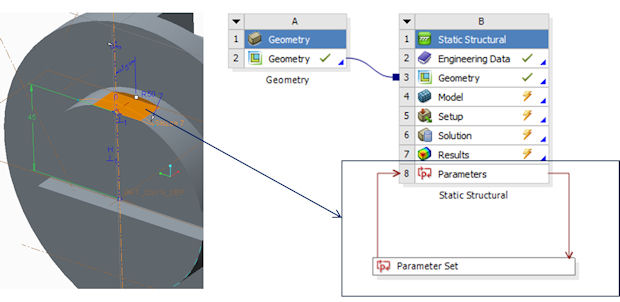Leveraging Parametric CAD Models with ANSYS Bidirectional Interfaces

February 17, 2015
 Dear Desktop Engineering Reader:
Dear Desktop Engineering Reader:
Obsolescence not only befalls us as we careen toward the far end of the actuary table, it also happens to a lot of jobs. Truth is that now-outmoded work is better being long gone. Take, for example, converting a CAD file into IGES, STEP or something for an FE (finite element), CFD (computational fluid dynamics) or some other engineering analysis.
Not too long ago you simply expected to be handed a neutral file for your simulations. Problem was that the neutral file was both dumb and dirty. To make it analysis-ready, you exhausted a great deal of time tediously cleaning and repairing the file and even recreating entities. And, since nothing is ever easy, while you were doing that, the CAD jockeys would often still be tweaking the original model. Ergo, when you finally had your analysis results, the design you analyzed was now obsolete, so you had to start all over again with a new translated file.
A terrific waste of resources that was the only way to get the job done. Which is why software developers like ANSYS have and continue to invest so much effort into ensuring that CAD and CAE work well with each other. ANSYS, of course, generally makes the news with its high-powered analysis portfolio. Not getting much press play is its native file bidirectional and associative integration with major CAD systems like Autodesk Inventor and Dassault Systèmes’ CATIA and SolidWorks. Which is interesting since having CAD and CAE work in unison is vital to a productive and efficient workflow.
Today’s Check it Out link addresses that media oversight. The link takes you to “Leveraging Parametric CAD Models with ANSYS Bidirectional Interfaces,” a Web resource ANSYS created to explain its bidirectional CAD and CAE interface capability and to demonstrate what’s in it for you. It’s good stuff.
Now, native CAD integration has been a part of the ANSYS Workbench analysis environment for something like 10 years, so the kinks are long gone while the competencies are up. The first, and pretty big, benefit you get is that you can use native CAD geometry directly, which eliminates the hassles inherent with translating a model into some intermediate geometric format. But the capability also provides flexibility to work with the file. What does that mean?
Well, say you import a Solid Edge file into ANSYS. You get the geometric entities you expect — bodies, faces and so on. But you also get attributes like materials and, importantly, dimensions. Since the integration is native, you can change those parameter values in the model’s geometry directly within the ANSYS Workbench simulation environment without opening Solid Edge. The integration is also bidirectional, meaning ANSYS sends the parameters back to Solid Edge, where the model is updated then shipped back for analysis.
The net effect here is that you set up a simulation model once and enter multiple dimensions you want to study. ANSYS handles the interactions with the CAD system then automatically analyzes your geometric variations. This, in turn, means that you can do more analyses in less time, which should lead to more robust designs.
On the “Leveraging Parametric CAD Models with ANSYS Bidirectional Interfaces” Web resource, you’ll find downloadable articles and brochures on the interface capability as well as an interesting webinar on the real-world use of ANSYS Mechanical for structural analysis. The highlight of the page is two 8-minute, registration-free, video demonstrations you’ll find smack in the middle. (Recommendation: Hit the full-screen mode and see everything very clearly.)
The videos use PTC’s Creo and Siemens PLM Software’s NX for their demonstration models, but the mechanism works in the same way with other supported CAD platforms. From the user’s point of view, the process appears easy to setup and execute as well as a productivity boost. Suffice it to say, the ANSYS bidirectional integration capability appears to be a long way from the slog of file repair of long ago. It’s worth learning more about. Hit today’s Check it Out link and see for yourself.
Thanks, Pal – Lockwood
Anthony J. Lockwood
Editor at Large, Desktop Engineering
Go to “Leveraging Parametric CAD Models with ANSYS Bidirectional Interfaces.”
Subscribe to our FREE magazine, FREE email newsletters or both!
About the Author
Anthony J. Lockwood is Digital Engineering’s founding editor. He is now retired. Contact him via [email protected].
Follow DE






